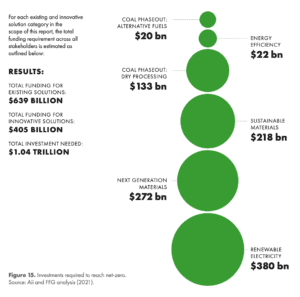Unlocking the Trillion-Dollar Fashion Decarbonisation Opportunity
Size of the Prize: The Trillion-Dollar Fashion Decarbonisation Opportunity
Size of the Prize: The Trillion-Dollar Fashion Decarbonisation Opportunity
For each existing and innovative solution category in the
scope of this report, the total funding requirement across all stakeholders is estimated as outlined below.

Given the breadth of these solutions, different methodologies have been used to arrive at each dollar value reported in Figure 15:
Renewable Electricity:
Higg FEM and the Open Apparel Registry were used to calculate the global electricity use of the apparel industry, which was multiplied by the average capital cost per MW for solar electricity installations.
Sustainable Materials and Processes:
Textile Exchange’s forecast of global textiles volumes was multiplied by the cost of collection and processing facilities that will be required to increase preferred materials volumes, along with the associated cost premium of sustainable materials to conventional materials.
Energy Efficiency:
The average cost to implement energy efficiency per facility was estimated using previous results from facilities that have completed the Clean by Design programme. This figure was then multiplied by this report’s estimate for the number of global facilities (149,792 global facilities by 2050).
Coal Phase Out: Alternative Fuels:
The total thermal energy use of the apparel industry was estimated and multiplied by EPA estimates for switching to natural gas.
Coal Phase Out: Dry Processing & Next Generation Materials:
The total number of innovators in Fashion for Good’s database in each innovation category was multiplied by an estimate for the capex cost required to scale each innovation.
Please see Appendix I for further information and a detailed methodology for these calculations.
While an investment in excess of $1 trillion over the next 30 years is certainly a large amount, the majority of this spend is for projects that offer an attractive financial, as well as environmental, return on investment. Part 4 of this report details the types of funders and financing mechanisms that will be required to reach this goal.
